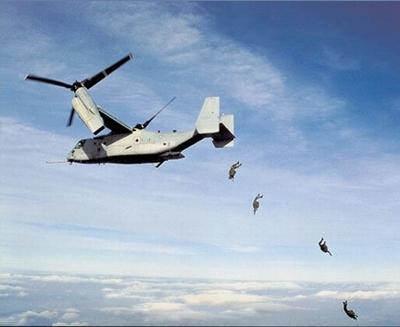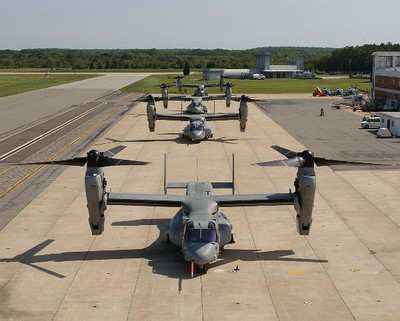Thu, Apr 08, 2004
Tests Include Air-To-Air Refueling
The Navy's V-22 Integrated Test Team (ITT) recently flew the
first air-to-air refueling flights since the program’s return
to flight in May of 2002, an operation deemed successful.

Over the course of two one-hour sorties using Osprey No. 22,
test pilots Marine Lt. Col. Kevin Gross and Steve Grohsmeyer each
logged five "dry plugs" behind an Air Test and Evaluation Squadron
(VX) 20 KC-130F operating near Naval Air Station Patuxent River
(MD).
The primary reason for the flights was to re-establish Gross and
Grohsmeyer’s day aerial refueling qualifications. Eventually,
the ITT will have six pilots qualified to tank day and night, and
at night while wearing night vision goggles--all part of the
developmental test plan.
"Air-to-air refueling is an easy task in the V-22," Gross said
after the flights. "The aircraft demonstrates positive and
predictable characteristics in all axes, but especially in the
thrust axis where the pilot’s ability to control closure
rates is important."
Gross said this particular refueling exercise was done at
airspeeds around 200 knots and an altitude of 10,000 feet.

Although Osprey No. 22 has an 11-foot fixed probe, the
qualification flights were the initial step toward testing the new
retractable refueling probe that will be installed on Osprey No.
21, currently being modified in Hangar 109 at Patuxent River. The
developmental testing of the retractable probe will begin early
next month and should last about three weeks. The retractable probe
is just over 9 feet long when extended but is flush with the nose
when stowed--a necessary feature for shipboard operations.
The V-22’s air-to-air refueling features are the
cornerstone of the improvements in self-deployment capability and
operational range over the legacy systems it will replace.
The air-to-air refueling developmental testing is just one area
where the ITT is supporting Tilt-Rotor Operational Test Squadron
(VMX) 22, the Osprey Test and Evaluation Squadron based at Marine
Corps Air Station New River (NC) as they prepare for OPEVAL next
year. Once developmental testing is complete--whether it is
air-to-air refueling, formation flight, or shipboard
operations--VMX-22 is cleared to begin operational testing in that
area.
More News
Aero Linx: The American Society of Aerospace Medicine Specialists (ASAMS) The Society is a non-profit organization created to serve as a voice for and represent the professional ne>[...]
Class C Service This service provides, in addition to basic radar service, approved separation between IFR and VFR aircraft, and sequencing of VFR aircraft, and sequencing of VFR a>[...]
Have A Story That NEEDS To Be Featured On Aero-News? Here’s How To Submit A Story To Our Team Some of the greatest new stories ANN has ever covered have been submitted by our>[...]
Also: ERAU Uses UAVs, P550 Group 2 UAS, Starship’s Florida Launches, NASA Missions Chopped The Air Force has put out a call to commission a one-to-one copy of the Iranian-des>[...]
Classic Klyde Morris From 11.07.16 (and Remembering Bob...) FMI: www.klydemorris.com>[...]
 ANN's Daily Aero-Linx (08.27.25)
ANN's Daily Aero-Linx (08.27.25) ANN's Daily Aero-Term (08.27.25): Class C Service
ANN's Daily Aero-Term (08.27.25): Class C Service ANN FAQ: Submit a News Story!
ANN FAQ: Submit a News Story! Airborne-NextGen 08.26.25: Iran UAV Knockoffs, X-37B Spaceplane, Army Training
Airborne-NextGen 08.26.25: Iran UAV Knockoffs, X-37B Spaceplane, Army Training Classic Klyde Morris (08.25.25)
Classic Klyde Morris (08.25.25)




